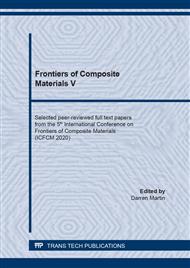p.47
p.57
p.69
p.75
p.81
p.89
p.95
p.101
p.107
Thermal and Mechanical Properties of Calcium Alginate Capsules for Self-Healing Asphalt Concrete
Abstract:
The key physical and mechanical property is the strength of the capsules, which ensure the implementation of the self-healing technology, in which the capsules are not destroyed during the compaction of the asphalt concrete mixture, but are destroyed during the formation of defects in the asphalt concrete. An increase in the content of the reducing agent in the composition of the alginate emulsion leads to a decrease in the breaking load during compression of the capsules, which is explained by an increase in their diameter. But the change in the content of sodium alginate does not have a significant effect on mechanical properties. As a result of exposure to a temperature of 170 °C, a decrease in the strength of the capsules by 22 % after 1 hour of exposure in the burning oven is observed, and with an increase in the time to 4 hours, the strength decreases by 46.9 %. The maximum decrease in the strength index after 4 hours of exposure at a temperature of 160 °C reaches 29.9 %. A decrease in temperature to 150 °C leads to a decrease in the loss of strength. The strength of the capsules decreases by 4 % after 4 hours of exposure at 150 °C. Exposure of capsules to a temperature of 140 °C has no significant effect on strength.
Info:
Periodical:
Pages:
101-106
Citation:
Online since:
August 2021
Authors:
Price:
Сopyright:
© 2021 Trans Tech Publications Ltd. All Rights Reserved
Share:
Citation:


